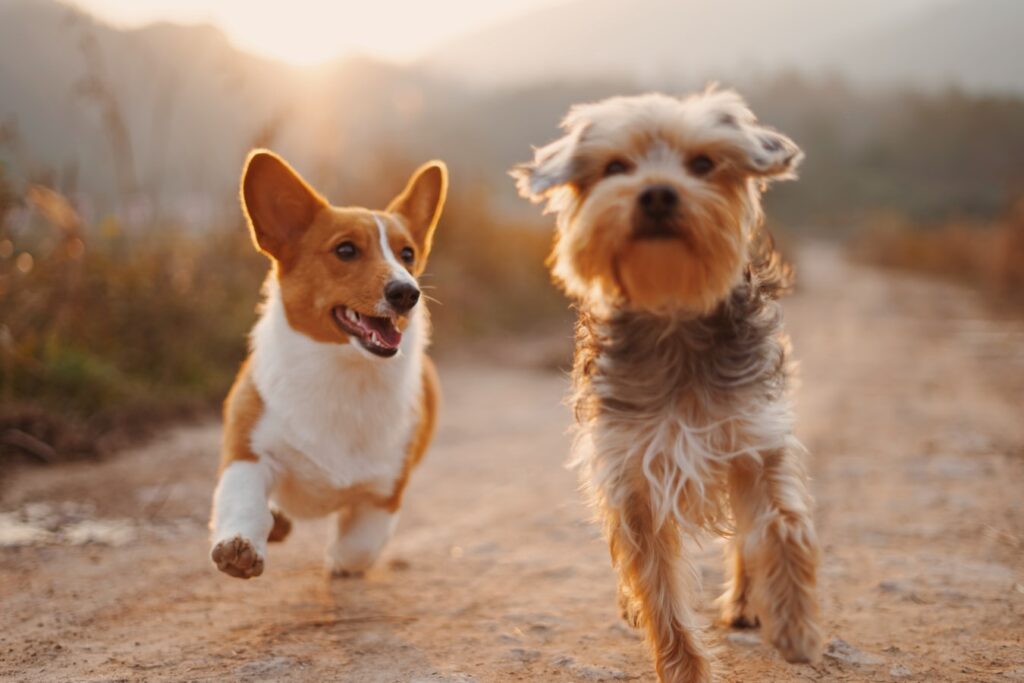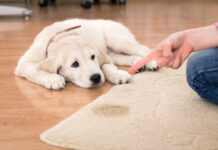
What is calm? The Cambridge dictionary defines calm as peaceful, quiet, and without worry; others state it is the absence of strong emotions. Calm is a word used to describe an emotional state, which we define by our own understanding and experience. When working with another species, we need to first explore and define what calm means to us, as well as describe what we believe it to look like in that species.
We cannot truly define what an individual feels as that is an internal state which everyone may experience differently. However, we can use behavioral labels such as calm to help communicate what we hypothesize the emotional state of an individual to be. When defining calm in a dog, it is important to know what the physical signs of stress are so we can gauge if these indicators are absence or present:
Typical physical signs of stress in a dog:

- Panting with a spoon-shaped tongue, excessively in relation to physical exertion recently undertook.
- Changes in the appearance of a puppy’s eyes. This presents as dilated pupils and rapid blinking; also eyes may be opened very wide and display more white than usual.
- Ears back and visibly tensed towards his head.
- Hunched/stiff movements.
- Inability to settle and rest/Hyperactivity – often presented as jumping up, dashing about with muscle tension, and no relaxation positions being assumed.
- Avoidance/escape – the dog may seem very distracted and or intently focus on something else. Some puppies will try to physically escape the environment by running away, digging, circling, or hide.
- Vocalization – whining/crying, barking, and growling can all be stress vocalizations.
- Shedding – the release of adrenaline hair can facilitate the sudden casting of hair by an individual.
- Digestive issues – not interested in taking food and or the inability to ingest food is common when the body is preparing itself for fight or flight. Also, loss of bladder and bowel control is common if an individual is extremely stressed.
At this point, it’s important to remember life is stressful! Stress responses are a normal part of daily life. They are designed for assisting survival by preparing an individual for fight or flight. These responses become harmful when triggered too intensely or for an extended duration. There is now research suggesting stress hormones can still be present in a pup’s system for up to 6 days after the stressful event! Therefore, is it important to monitor an individual’s response and help it to learn how to be calmer as stress can have an accumulative effect?
What are the causes of stress?

Every day we are all surrounded by potential stress triggers—previous experience or lack of dictates how these stressors can affect an individual. Interactions with particular physical environments such as a visit to the vets may have a negative association for a pup, as when they went previously, they had to receive treatment that was uncomfortable or triggered a pain response.
-
Health
It’s vital to ensure that when embarking on teaching our pets to be calm that we ensure they are healthy and that a medical issue is not causing stress. If you have any concerns about your doggy health, contact a professional veterinarian for advice. Also, ensure he is receiving the nutrition that it requires, in an easily digestible form and how it is feed is an enriching, NOT frustrating experience.
-
Exercise and stimulation
Exercise can add to the stress! It needs to be carried out in the right environment and at the correct intensity for you and your pet to be a benefit. Too much physical exertion can send a dog over its threshold. It has been hypothesized that certain activities, such as a constant ball or Frisbee chasing, for more than 30 minutes, can cause over-arousal for several days if the pup is not allowed a suitable recovery period. Stimulation should be enriching, not frustrating, and rest days for individuals displaying chronic stress are vital.

Cooper L (2015) discusses providing a calm daily regime where exercise has opportunities for the puppy to use its amazing olfactory ability is useful. In combination with appropriate mental stimulation and enrichment, there appears to be a positive change in the behavior and body language exhibited by reactive doggies. The results of Cooper’s study suggest that for the more extended period a pup is exposed to a program of relaxation, coupled with low levels of appropriate exercise, the more likely a positive change in behavior will be noted, and he able to listen and learn.
-
Noise
Its well documented that dogs sense and range of hearing is far more sensitive than that of humans, and certain noises such as a loud bang can trigger a startle response and may even cause discomfort due to the intensity of it. Upon hearing an unfamiliar noise, the brain will process based on learning history if the noise is familiar and safe or not. Often early exposure to a variety of noises will help him be more resilient to noise, and if noise issues do develop its important to start a suitable de-sensitization program straight away, otherwise noise phobias often develop.
Solutions in teaching your dog how to be calm

There are many ways in which we can help our dogs to become calmer and relaxed. These start with us and our behavior. Be conscious of how you react towards your pup when it develops signs of stress, watch your body language, and learn how to become more relaxed by a pause for a moment before you react to your pup’s behavior and compose yourself. Try to keep your tone of voice tone neutral and avoid touching your pet unless he seeks physical reassurance from you. Reinforce with eye contact, verbal praise, and communicate effectively through previously trained cues. Puppies who have built an attachment to their owner generally are better at coping with stress, with stress increasing during separation from the caregiver, which decreases after the reunion.
When building a strategy to teach your dog to be calm list your stress triggers i.e. your pup barking, jumping up, etc and asses how do you behave and respond. Why does it make you feel stressed? What can you teach your pet to do instead? Develop positive strategies for when stress arises and have an escape plan that ensures you can safely remove your dog from a situation should you need to.
Implement desirable lifestyle changes for your pet by adding suitable fresh food to its diet and providing it with access to a quiet, cozy den. Become conscious of what triggers a stress response in him and focus on positive feedback for calm behavior. Set the environment up for success and ensure tasty reinforcers are easily available. For example, place secure pots of tasty treats inaccessible locations to enable you to deliver reinforcement and reward doing nothing so your dog learns being relaxed is reinforcing.

Provide suitable enrichment through feeding and go find games. Also, remember to let him have un-interrupted rest and regular breaks from exercise.
-
Environment
Is the key to facilitating calm in an individual, so ensure your doggy spends most of its time in a setting where is displays relaxed body language and appears to be comfortable. Provide access to a safe, secure, easily reached, quiet den where he learns it can go to and won’t be disturbed. Help to improve your pet’s life experience by setting his environment up for success, whenever possible.
-
Scent
Certain scents have shown signs of being effective in calming when they are in the environment, plus engagement in activities that involve using olfactory and problem-solving abilities are known to promote calm behavior in puppies (Mackinnon, 2014). Look at engaging him in scent work and playing scent games with them to utilize the calming benefits these activities have.
How to teach a doggy to be calm?
Training – teaching your dog foundation behaviors will ensure you have a positive and effective means of communicating with them. It also will provide you with behaviors that you can guide him towards to help prevent it from becoming stressed and can provide a safe way to assist removing your pup from a stressful situation. For example, stationing/bed/crate training enables you to cue him to seek out and go to a safe base where it can remain secure, helping to engage it in an activity that it feels comfortable and confident in. Through having a positively reinforced repertoire of trained behaviors, you are providing yourself and your dog with invaluable resources to draw upon as and when the need arises.
Start the training in a quiet environment where your puppy shows signs of being relaxed, without distractions and as the selected behaviors become reliable you can start to increase the level of distractions and re-teach in a variety of environments. Research and learn about how to use free shaping clicker training to teach your doggy to offer behaviors, build its confidence in allowing it control in a situation, and improve your training mechanics. Engaging in fun activities will facilitate the release of feel-good hormones and improve the mood state of both the learner and teacher.
For more information and professional online courses, visit Tromplo.com.
Calm is reliant on ensuring health and wellbeing and can be facilitated through utilizing suitable and enriching environments and constructive experience. Through working with your pup in a positive and enjoyable manner you will build trust and understanding, which are vital in promoting a calm and harmonious relationship between pet and human.
Teach your doggy to be calm, and you will both enjoy and appreciate reaping the benefits.














